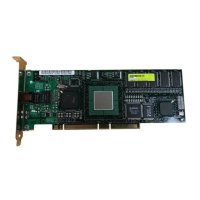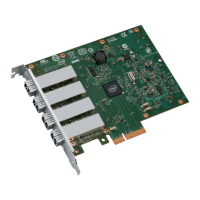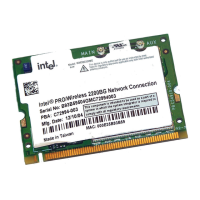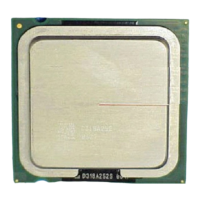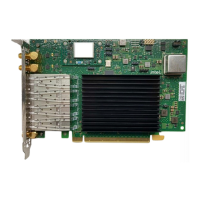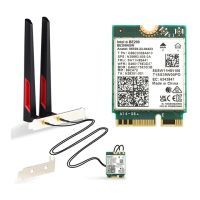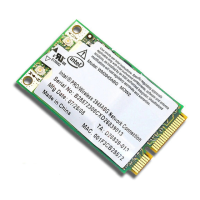
Do you have a question about the Intel 1000BASE-T and is the answer not in the manual?
Lists standards and specifications relevant to compliance testing.
Explains fundamental principles for physical layer compliance testing.
Lists the minimum equipment necessary for performing tests.
Details required fixtures and components for test setups.
Information on software utilities and data patterns for UUT configuration.
Overview of minimum tests for board design and implementation validation.
Measure peak differential output voltage and examine channel linearity.
Defines required voltage levels and amplitude symmetry for test points A, B, C, D.
Lists necessary equipment: oscilloscope, differential probe, and UUT software.
Specifies the 100 Ohm UTP test load fixture.
Step-by-step guide for connecting equipment and configuring settings.
Ensure the LAN analog front end handles DC bias.
Defines minimum amplitude ratios for points G/F and J/H.
Lists oscilloscope, differential probe, and UUT software.
Specifies the 100 Ohm UTP test load fixture.
Procedure for adjusting oscilloscope and measuring output voltage ratios.
Determine UUT receiver sensitivity at various cable lengths.
Receiver must have a frame error rate < 10^-7 for 125 octet frames.
Requires UUT, link partner PC, and specific software.
Various lengths of Category 5 cable (1 to 100 meters).
Connect UUT and partner, establish link, and perform receive option.
Formula and explanation for calculating Bit Error Rate.
Verify receiver tolerance to injected differential noise.
Receive BER must be < 10^-10 with injected crosstalk noise.
Requires UUT, second PC for idle signals, third PC for link partner.
Lists fixtures 40-28A, 40-28B, RJ-45 coupler, and 40.6.1.1.1.A.
Perform baseline BER, then inject noise and re-test for each channel.
Measure the return loss on all four channels at the MDI.
Defines minimum return loss (dB) from 1 MHz to 100 MHz.
Requires network analyzer, BNC cable, and UUT software.
Lists fixtures 40.8.3.1.A, 40.8.3.1.B, and 40.8.3.1.C.
Connect equipment, calibrate analyzer, and measure return loss.
Measure and record the common-mode output voltage of the transmitter.
Common-mode output voltage must be less than 50 mV peak-to-peak.
Requires oscilloscope and differential probes.
Specifies Test Fixture 40-32.
Connect test fixture, adjust scope, and measure positive/negative common-mode voltage.
Measure peak differential output voltage at UTP connector transmit pins.
Defines UTP differential output voltage range: 950 mV to 1050 mV.
Requires oscilloscope, differential probe, and host computer with software.
Specifies the 100 Ohm UTP test load.
Connect equipment, select test, configure oscilloscope, and measure voltages.
Measure the overshoot of the differential waveform.
Differential signal overshoot must not exceed 5%.
Requires oscilloscope, differential probe, and host computer with software.
Specifies the 100 Ohm UTP test load.
Configure scope, measure overshoot, and verify decay within specified time.
Measure the voltage symmetry of positive and negative waveforms.
Ratio of +VOUT magnitude to -VOUT magnitude must be between 0.98 and 1.02.
Calculate the ratio of +VOUT to -VOUT using results from Section 9.
Measure the transmitter return loss.
Defines return loss characteristics for UTP AOI from 2 MHz to 80 MHz.
Requires network analyzer, S-parameter test set, and host computer.
Lists balun test fixture, BNC cable, calibration fixture, and CAT5 cable.
Connect equipment, calibrate analyzer, and measure return loss across frequencies.
Measure rise and fall times of non-scrambled bit patterns.
Defines rise/fall times (3.0-5.0 ns) and variation (< 0.5 ns).
Requires oscilloscope, differential probe, and host computer.
Specifies the 100 Ohm UTP test load.
Configure scope, measure rise/fall times using cursors.
Measure duty cycle at MLT-3 transitions using a non-scrambled pattern.
50% crossing times must be between 15.50 ns and 16.50 ns.
Requires oscilloscope, differential probe, and host computer.
Specifies the 100 Ohm UTP test load.
Configure scope, transmit data pattern, and measure pulse widths.
Measure jitter of the scrambled waveform output from the UUT.
Peak-to-peak jitter must not exceed 1.4 ns.
Requires oscilloscope, differential probe, and host computer.
Specifies the 100 Ohm UTP test load.
Configure scope, find eye pattern, and measure jitter using vertical cursors.
Measure Bit Error Rate (BER) of UUT over CAT5 cable.
Receiver must have BER less than 10^-8.
Requires transmit computer, host computer, and software.
Various lengths of Category 5 cable (1 to 100 meters).
Connect UUT and partner, establish link, and perform BER test.
Formula and explanation for calculating Bit Error Rate.
Measure the receiver return loss.
Defines return loss requirements for UTP AII from 2 MHz to 80 MHz.
Requires network analyzer, S-parameter test set, and host computer.
Lists balun test fixture, BNC cable, calibration fixture, and CAT5 cable.
Turn on analyzer, calibrate, and measure return loss.
Verify the TD circuit peak differential output voltage.
Peak differential output voltage on TD circuit shall be between 2.2 V-pk and 2.8 V-pk.
Requires oscilloscope, differential probes, and host computer.
Specifies the 100 Ohm resistive load.
Connect equipment, select test, configure scope, and measure voltages at 5MHz/10MHz.
Verify the harmonic content at the transmitter output.
Harmonics must be at least 27 dB below the fundamental frequency.
Requires Spectrum Analyzer, CAT 5 cable, and BNC cable.
Specifies Balun Test Fixture with 200 MHz or greater bandwidth.
Connect cable and balun, select test, adjust analyzer, and record harmonics.
Measure the transmitter return loss.
Return loss must be >= 15dB from 5 MHz to 10 MHz.
Requires Network Analyzer, CAT 5 cable, and BNC cable.
Lists Balun Test Fixture and Load Fixture for calibration.
Connect cable and balun, calibrate, and measure return loss.
Measure and record the common-mode output voltage of the transmitter.
Common-mode voltage must be less than 50 mV peak.
Requires oscilloscope, differential probes, and host computer.
Specifies Test Fixture 14-14.
Connect fixture, set scope, and measure positive/negative common-mode voltage.
Verify jitter added by UUT propagating through a cable model.
Jitter added must be no more than 12.0 ns.
Requires oscilloscope, differential probes, and CAT 5 cable.
Specifies 100 Ohm UTP test load and twisted pair model.
Connect equipment, select test, configure scope, and measure jitter.
Verify jitter added by UUT driving a 100 Ohm resistive load.
Jitter added must be no more than 11.0 ns.
Requires oscilloscope, differential probes, and CAT 5 cable.
Specifies the 100 Ohm UTP test load.
Connect equipment, select test, configure scope, and measure jitter.
Measure the Bit Error Rate (BER) of the UUT.
Receiver must have a bit error rate of less than 10^-8.
Requires transmit computer, host computer, and software.
Various lengths of Category 5/3 cable (1 to 100 meters).
Connect UUT and partner, establish link, and perform BER test.
Formula and explanation for calculating Bit Error Rate.
Verify the differential input impedance.
Return loss must be >= 15 dB from 5 MHz to 10 MHz.
Requires Network Analyzer, CAT 5 cable, and BNC cable.
Lists Balun Test Fixture and Load Fixture for calibration.
Connect cable and balun, calibrate, and measure return loss.
Describes test fixture 40-25 which terminates channels with 100-ohm loads.
Details a short cable for transmitter jitter and alien crosstalk tests.
Describes a cable for master/slave transmit jitter tests, with specific segments.
Describes Fixture 40.8.3.1.A, a Balun test fixture.
Describes Fixture 40.8.3.1.B for network/spectrum analyzer calibration.
Describes Fixture 40.8.3.1.C, a square pin fixture for MDI return loss.
Describes Fixture 40-28A for alien crosstalk noise rejection test.
Describes Fixture 40-28B, also used for alien crosstalk noise rejection.
Describes Fixture 40-32 for common-mode output voltage testing.
Provides guidelines for building test fixtures with emphasis on wire gauge and component matching.
Details RJ-45 connector pin assignments and Ethernet cable wire configurations.
Instructions for constructing 120-ohm impedance segments for jitter test cables.
Diagram and description of the 100 Ohm UTP Test Load fixture.
Diagram of the 100Base-TX Balun Test Fixture.
Description of an optional Open Circuit Inductance Test Fixture.
Description of an optional Receiver Common-Mode Rejection Test Fixture.
Diagram of the 10Base-T Balun Test Fixture.
Diagram of the Common-Mode Output Voltage Test Circuit (Fixture 14-14).
Schematic of the 10BASE-TX 14_7 Twisted-Pair Model.
Explains measuring insertion loss of Ethernet cable and calculating length.
Method for setting up and calibrating a network analyzer for cable measurements.
Procedure for connecting cables and measuring insertion loss at 16 MHz.
Describes alternative, less accurate methods for measuring cable insertion loss.
Explains how cable irregularities affect impedance and measurement results.
Common problems encountered during testing and their potential causes.
Ensuring oscilloscope and probe meet specs, correct channel selection, and connections.
Ensuring network analyzer is in correct mode, configured properly, and calibrated.
Factors causing PHY conformance test failures and prevention methods.
Troubleshooting high/low differential output voltage and its impact.
Troubleshooting excessive overshoot and probe requirements.
Troubleshooting incorrect amplitude symmetry and its effects.
Troubleshooting system failures to meet return loss specifications.
Troubleshooting slow/fast rise/fall times and their impact.
Troubleshooting issues related to open circuit inductance in transformers.
Troubleshooting receiver issues caused by duty cycle distortion.
Troubleshooting causes of jitter and its impact on receiving units.
Troubleshooting BER issues related to differential input signals.
Troubleshooting common mode noise and its rejection.
Manual register settings for 82540 and 82546 Intel Ethernet families.
Manual register settings for 82541 and 82547 Intel Ethernet families.
Manual register settings for the 82544 Intel Ethernet family.
Explains how to perform 100Base-TX physical layer testing with the 82544 chip.
Lists test equipment, PCs, software, and fixtures required for 82544 chip tests.
Details the test case, purpose, specification, equipment, fixtures, and procedure.
Details the test purpose, specification, equipment, fixtures, and procedure.
Details the test case, purpose, specification, equipment, and fixtures.
